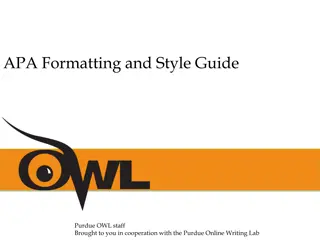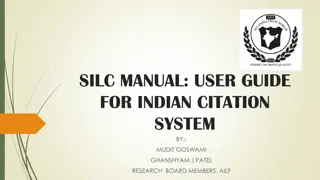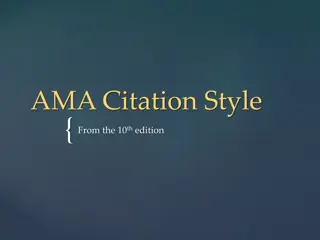Proper Citation in APA Style for Academic Writing
Citing studies in the text using American Psychological Association (APA-6th edition) style can be done directly or indirectly. Learn how to cite works by single authors, multiple authors, and groups as authors according to APA guidelines.
Download Presentation

Please find below an Image/Link to download the presentation.
The content on the website is provided AS IS for your information and personal use only. It may not be sold, licensed, or shared on other websites without obtaining consent from the author.If you encounter any issues during the download, it is possible that the publisher has removed the file from their server.
You are allowed to download the files provided on this website for personal or commercial use, subject to the condition that they are used lawfully. All files are the property of their respective owners.
The content on the website is provided AS IS for your information and personal use only. It may not be sold, licensed, or shared on other websites without obtaining consent from the author.
E N D
Presentation Transcript
Citing Studies in the Text American Psychological Association Style (APA-6th edition) Citing others work can be done directly or indirectly. PS. Only surnames of the authors are used!!
INDIRECT CITATION Citing a work by single author If the name of the author appears in the text: Thus, there have been concerns regarding the effectiveness of standardized testing in assessing writing. In an attempt to overcome some of the problems associated with standardized testing, many researchers have advocated assessment procedures that are ongoing and process-oriented. For example, Stiggens (2005) calls for the use of assessment for learning models that focus on ongoing formative assessment of students progress rather than the widely used assessment of learning models which are more static in nature and are limited to testing the end product of learning through measuring students achievement rather than their progress.
If the name of the author does not appear in the text: The advent of DA is relatively new in the field of educational assessment in general and in the field of second language assessment in particular (Ableeva, 2009).
Citing a work by two authors Surnames of both authors are used all the time: According to Lantolf and Poehner (2005), formative assessment methods seem to implicitly consider assessment and instruction as two separate entities where the role of assessment is simply to bring about change in instruction. Following that, a review of literature on formative assessment is presented since formative assessment can be considered one way to overcome many of the problems associated with standardized testing in addition to being compared to DA in aiming for ongoing assessment rather than focusing on final achievement testing only (Lantolf & Poehner, 2005).
Citing a work with 3 or more authors Write all the names when you first cite them: The theoretical underpinnings of DA can be traced back to the Vygotskian concept of Zone of Proximal Development and the theory of Mediated Learning Experience (Feuerstein, Rand & Hoffman, 1979). In subsequent citations, include only the surname of the first author followed by et al . Thus, one can see the similarities between Vygotsky s ZPD and Feuerstein et al. (1979) MLE since both emphasize the role of intervention by a more capable peer in promoting development.
Citing groups as authors When cited the first time, the name of the group is written. In 2000, Department of Immigration and Ethnic Affairs (DIEA) Use the abbreviation when cited again DIEA (2000) reported that
Citing works with no authors If a work does not have author, use the first two or three words of the title and capitalize each word. Italicize them and use double quotation mars A special one-off visa category was announced ( Assessment Criteria , 2001).
DIRECT CITATION If you want to use others words as they are, you must use quotations and the page number. For a quotation of fewer than 40 words (4 lines) Testing, on the other hand, is a special form of assessment administered under contrived circumstances. In other words, all tests are assessments, but not all assessments are tests (Kizlik, 2009, p. 1). Lantolf and Poehner (2004) contend that dynamic assessment integrates assessment and instruction into a seamless, unified activity aimed at promoting learner development through appropriate forms of mediation that are sensitive to the individual s (or in some cases a group s) current abilities (p. 50).
A quotation of more than 40 words must be set apart from the text (block quotation). The left margin of the block should be set in from the left margin by the same spacing as the first line of a new paragraph. Sample 1 In accordance with this point of view, Yancey (1999) further adds the following: This model of writing assessment, with its different genres and multiple texts and classroom writing environment, seemed more valid still. But built into the model was another new feature, a reliability based not on statistics, but on reading and interpretation and negotiation. (p. 492)
Sample 2 that it is sometimes necessary for testing to lead the way: We believe that language testers can serve linguistic theory by examining the way in which their tests work, how their different components interrelate, and what they reveal about candidates language proficiency. Insights from such an analysis of test results should contribute to the development of a better understanding of what is involved in knowing and using language. (Alderson, 1992, p. 164)
Books One Author King, M. (2000). Wrestling with the angel: A life of Janet Frame. Auckland, New Zealand: Viking. Two authors Trevin o, L. K. & Nelson. K. A. (2007). Managing business ethics: Straight talk about how to do it right. Hoboken, NJ:Wiley.
Three authors and above Krause, K.-L., Bochner, S., & Duchesne, S. (2006). Educational psychology for learning and teaching (2nd ed.). South Melbourne, Vic., Australia: Thomson. Book or report by a corporate / group author World Health Organization (2008). WHO global report on falls prevention in older age. Geneva, Switzerland: Author.
Periodicals/Journals Journal Article /Printed Shepherd, R. (2008). Strategic position and performance of winter destinations. Tourism Review, 63(4), 40-57. Journal Article / Internet Only Snell, D., & Hodgetts, D. (n.d.). The psychology of heavy metal communities and white supremacy. Te Kura Kete Aronui, 1. Retrieved from http://www.waikato.ac.nz/wfass/tkka.
Webpages Statistics New Zealand. (2007). New Zealand in profile 2007. Retrieved from http://www.stats.govt.nz. University of Waikato, Law Library. (n.d.). Commentary. Retrieved July 19, 2009, from http://law.waikato.ac.nz:8080/lrs/index.
Online Newspaper Article Greder, A. (2015, September 9). Successful health-care initiative looks to expand. Duluty News Tribune. Retrived from http://www.duluthnewstribune.com
References Black, P. & Wiliam, D. (1998). Assessment and classroom learning. Assessment in Education, 5(1), 7-74. Black, P. & Williams D. (2004). Inside the black box: raising standards through classroom assessment. In S. Chappuis, R. J. Stiggins, J. Arter, and J. Chappuis (Eds.), Assessment for Learning: An Action Guide for School Leaders (pp. 10-21). Portland, OR: Assessment Training Institute. Boud, D. (2000). Sustainable assessment: rethinking assessment for the learning society. Studies in Continuing Education, 22(2), 151-167. Clapham, C. (2000). Assessment and testing. Annual Review of Applied Linguistics, 20, 147-161. Gaines, B. R. & Shaw, M. (2010). Webgrid 5. http://gigi.cpsc.ucalgary.ca:2000 Hamp-Lyons, L. (2007). The impact of testing practices on teaching: ideologies and alternatives. In J. Cummins and C. Davison (Eds.), The International Handbook of English Language Teaching, Vol. 1 (pp. 487-504). Norwell, MA: Springer.























